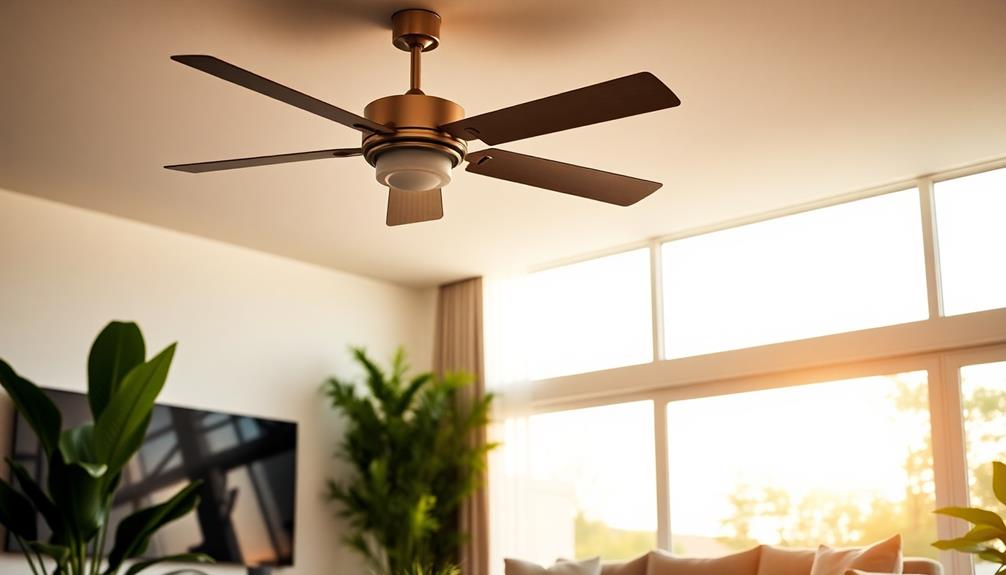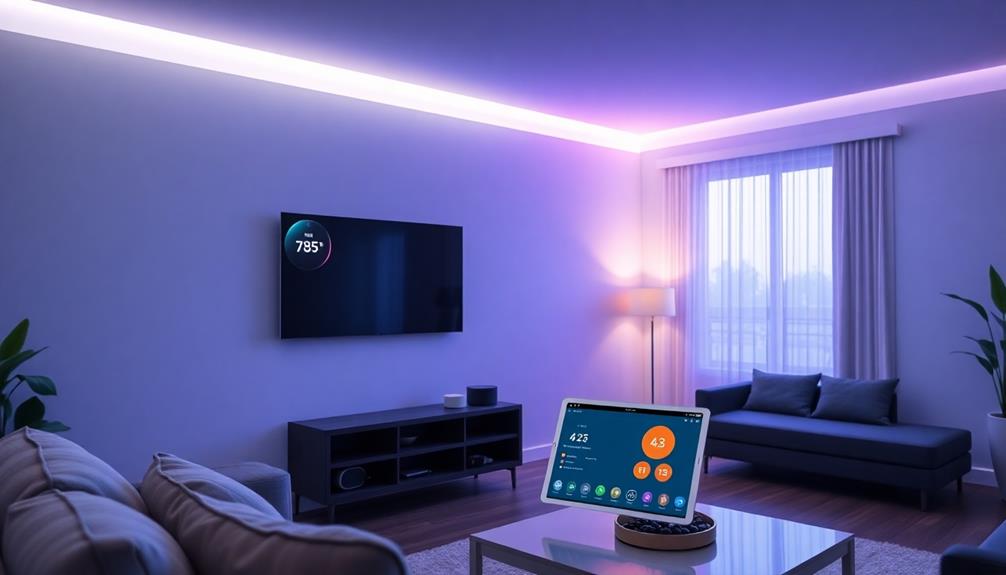Accessing the power of remote ceiling fans makes your life easier and more comfortable. You can effortlessly adjust fan speed, direction, and even set timers right from your couch. With remote-ready technology, this convenience fits perfectly into today's tech-savvy lifestyle. Say goodbye to ladders for reach or tangled pull chains. Installation is straightforward, ensuring you maximize the fan's features without hassle. Plus, you'll appreciate the energy efficiency and improved air circulation in larger or high-ceiling rooms. Ready to discover all the ways remote ceiling fans elevate your living space? You might find some surprising tips ahead!
Key Takeaways
- Remote ceiling fans provide convenient control over speed, direction, and light settings from anywhere in the room.
- Installation involves connecting a receiver and pairing the remote, ensuring seamless operation.
- Troubleshooting common issues like battery replacement and resetting can quickly resolve connectivity problems.
- Regular maintenance and safety checks ensure safe and efficient fan operation.
- Remote ceiling fans enhance comfort, energy efficiency, and align with modern home automation trends.
Understanding Remote Ready Ceiling Fans
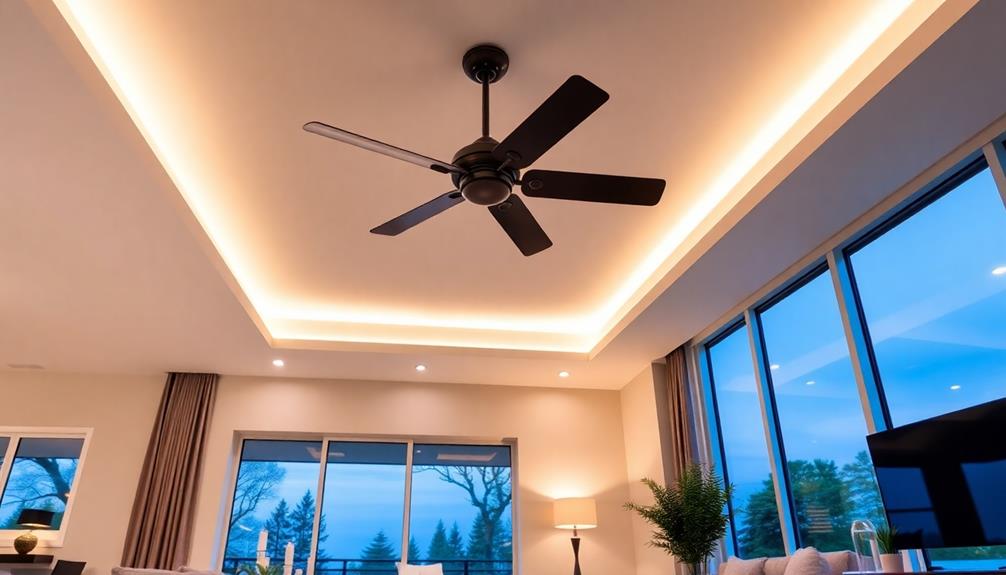
When it comes to modern ceiling fans, understanding "remote ready" technology is essential. This term means that your fan can work with remote control devices, letting you adjust speed, power, and blade direction from anywhere in the room.
It's especially useful in larger spaces or homes with high ceilings, where reaching for manual switches can be a hassle. Look for key features like a built-in receiver, multiple speed settings, and wireless operation.
With over 60% of homeowners preferring remote-ready fans, it's clear that convenience is a top priority. This technology enhances your comfort and aligns with contemporary living trends, making it a smart choice for your home.
Installation and Setup Process
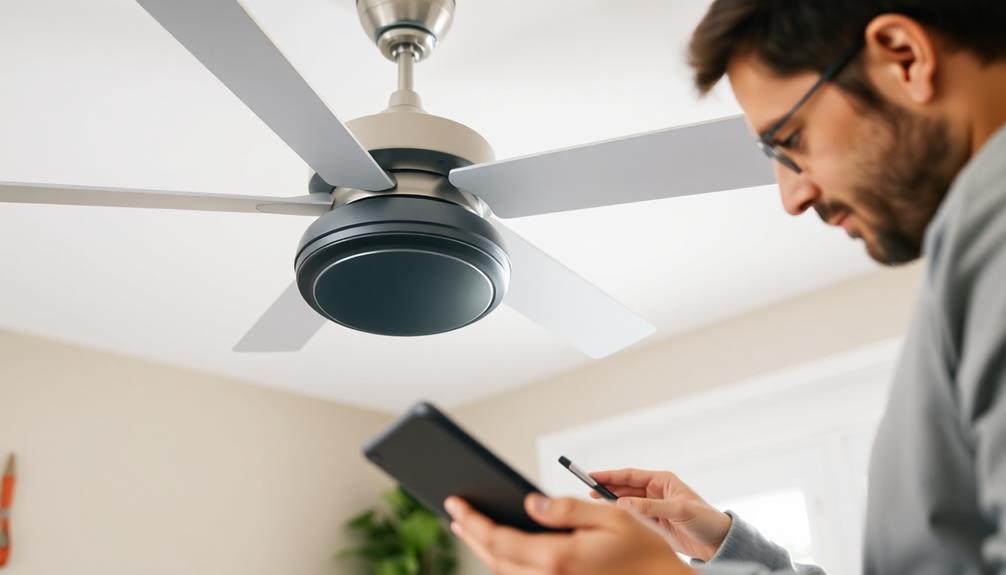
Installing a remote-ready ceiling fan brings convenience to your living space, but it's essential to follow the correct setup process to guarantee proper functionality.
Begin by checking the fan's canopy for a receiver and verify compatibility with the remote. Next, connect the receiver according to the manufacturer's instructions.
After that, pair the remote control with the fan; this usually involves pressing specific buttons. Once paired, secure the fan to the ceiling, making sure all connections are tight and safe.
Finally, turn on the power and test the fan's operation. Make any necessary adjustments to the settings to verify everything works correctly. Ensure that the fan blades are rotating in the intended direction and at the desired speed. If you notice the fan spinning in reverse, consult the user manual or adjust the direction switch to correct it. Once everything is functioning smoothly, you can enjoy the comfort of your properly installed fan.
Following these steps will help you enjoy the benefits of your new remote-ready ceiling fan efficiently.
Remote Control Functionality
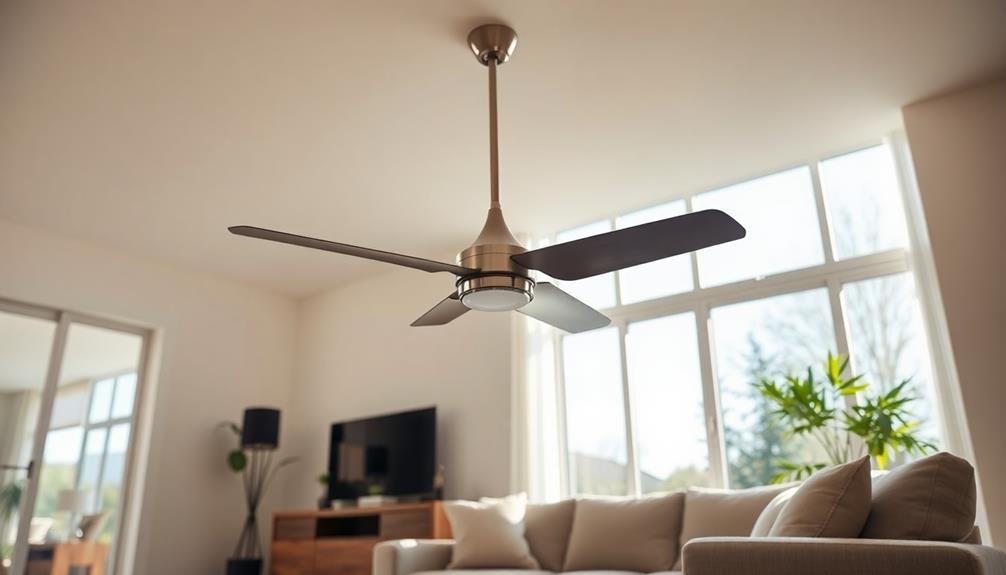
Experience the convenience of remote control functionality with your ceiling fan, allowing you to adjust settings effortlessly from anywhere in the room.
With just a push of a button, you can:
- Change Fan Speeds: Easily switch between low, medium, and high settings for ideal airflow.
- Adjust Fan Direction: Change the spin direction to enhance cooling in summer or heating in winter.
- Set Timers: Program your fan to turn off automatically, saving energy and ensuring comfort.
- Control Lights: If your fan has light features, you can dim or brighten them with the remote.
These features transform your ceiling fan into a versatile tool for comfort, making it a valuable addition to your living space.
Troubleshooting Common Issues
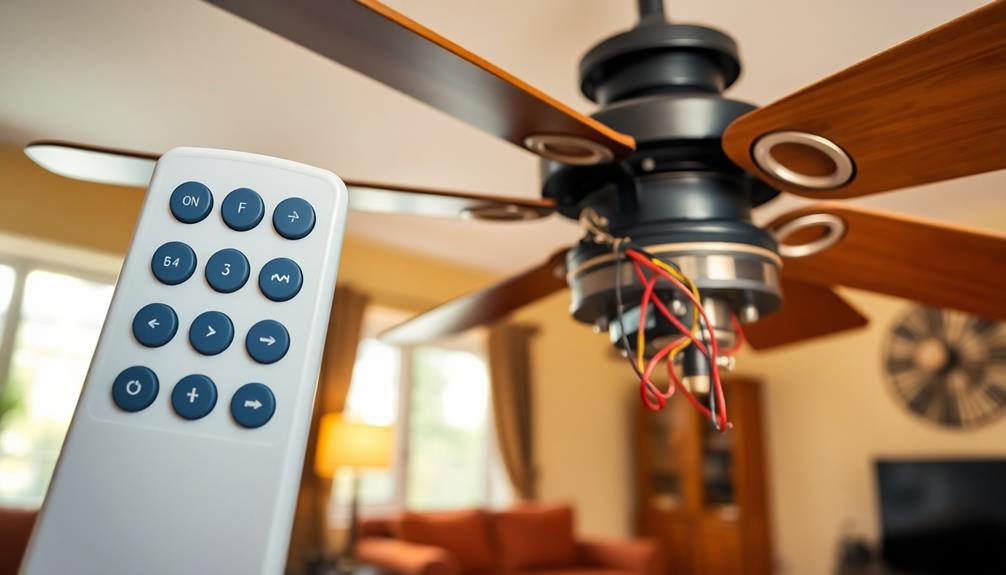
Troubleshooting common issues with your remote control ceiling fan can save you time and hassle.
First, check the batteries in your remote; they might need replacing or reinstallation. If the fan isn't responding, confirm there aren't any obstructions between the remote and the fan.
Sometimes, resetting both the remote and the receiver can resolve connectivity problems. If the fan still won't work, verify that the dip switch settings on both devices match.
Regularly check your remote's batteries to maintain peak performance. If issues persist, consult the manufacturer's guidelines or customer support for further assistance.
Addressing these common problems can keep your ceiling fan running smoothly and efficiently.
Safety Considerations
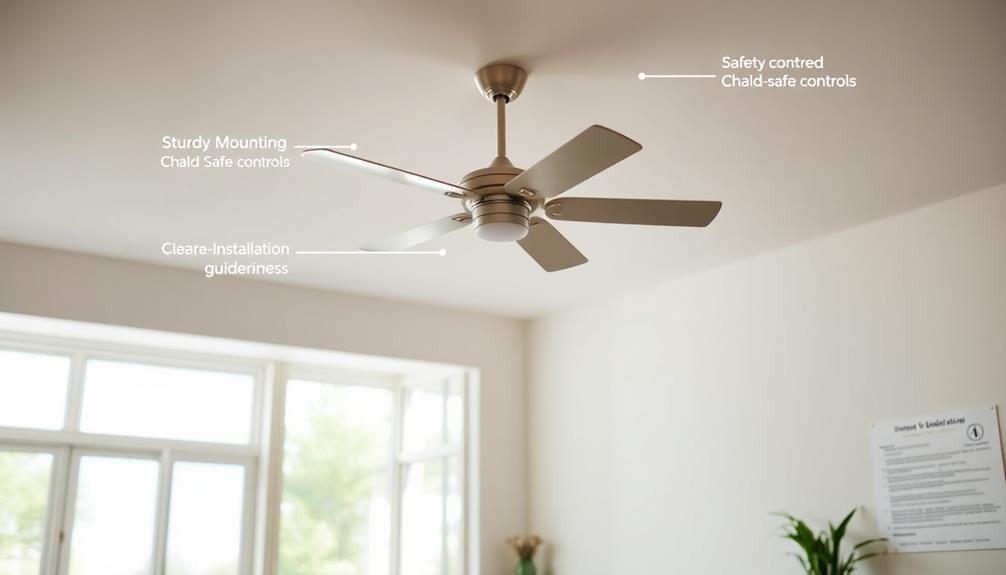
Addressing remote control issues can enhance your ceiling fan's performance, but safety should always come first.
To guarantee safe operation, keep these considerations in mind:
- Follow Manufacturer Guidelines: Always adhere to the installation instructions to avoid electrical hazards.
- Regular Maintenance Checks: Inspect your fan regularly for any signs of wear or damage, guaranteeing everything functions correctly.
- Battery Management: Regularly check and replace remote batteries to prevent malfunction or unexpected failures.
- Clear Pathways: Guarantee there are no obstructions in the fan's vicinity to avoid accidents when adjusting settings.
Market Options for Remote Controls
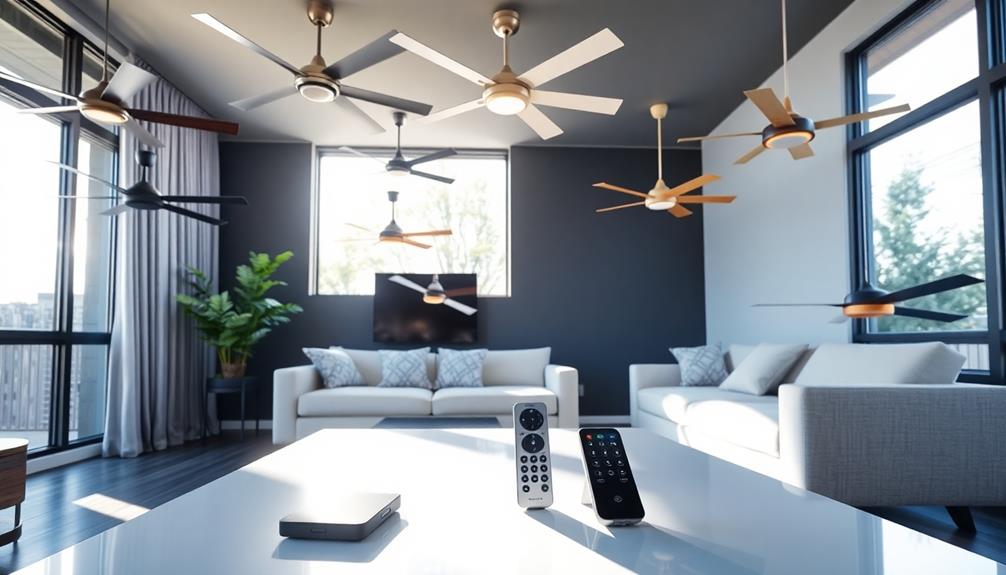
When it comes to choosing remote controls for ceiling fans, you've got plenty of options that cater to various needs and preferences.
You can opt for universal remotes, which allow you to control multiple fans from one device, minimizing clutter. For specific brands, consider options like the FAN35T series, designed to replace remotes for various ceiling fan models.
If you own a Harbor Breeze fan, the Anderic RRTX015 is a great choice, offering multi-speed settings and light dimming features.
Online marketplaces are filled with these products, making it easy to find the right fit for your needs.
Always verify the remote's compatibility with your ceiling fan model to enhance your experience seamlessly.
Consumer Preferences and Trends

Increasingly, homeowners are prioritizing remote control functionality in ceiling fans due to its convenience and ease of use.
You might find that this trend stems from several key preferences:
- Convenience: Adjust settings from anywhere in the room without getting up.
- Customization: Easily switch between multiple speed settings to match your comfort.
- Safety: Reduce the risk of falls since you won't need to reach for pull chains.
- Modern Living: Aligns with today's tech-savvy lifestyles, enhancing home automation.
These preferences reflect a growing desire for functionality that simplifies daily life, allowing you to enjoy a more comfortable and efficient living environment.
With remote control options, you'll find ceiling fans that cater to your needs and enhance your home experience.
Benefits of Remote Ceiling Fans
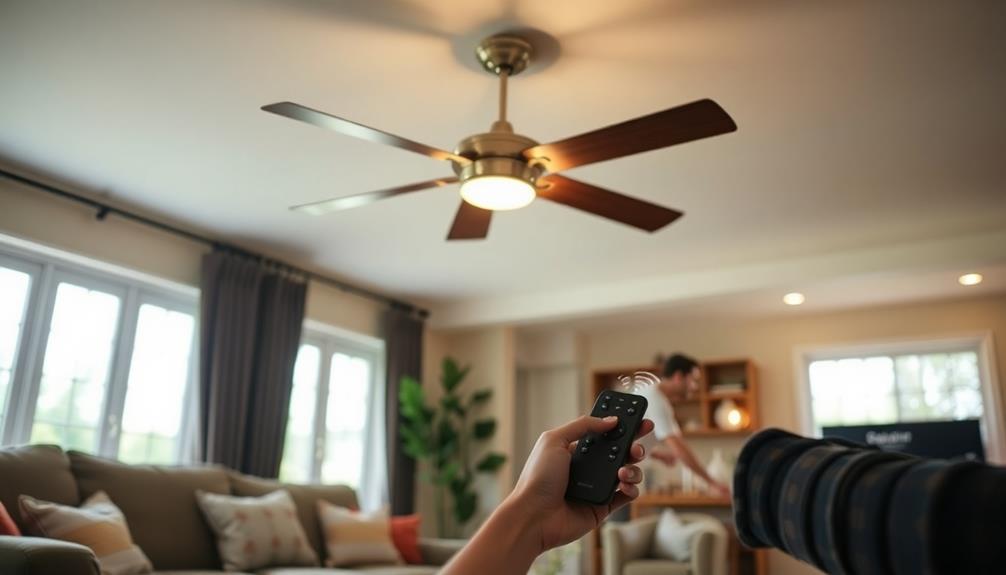
With the convenience of remote control functionality, remote ceiling fans offer a range of benefits that enhance your overall comfort and efficiency at home.
You can easily adjust fan speeds and settings from anywhere in the room, making it convenient to create the perfect atmosphere for any occasion. This feature is especially beneficial for high ceilings, as it eliminates the need for ladders or reaching for pull chains.
Remote ceiling fans also often come with added features like timers and light controls, allowing you to customize your experience further.
Plus, the energy efficiency of these fans can lead to lower electricity bills, making them a smart investment for any homeowner looking to improve their living space.
Frequently Asked Questions
Can Remote Ceiling Fans Be Used Outdoors?
Yes, you can use remote ceiling fans outdoors, but make certain they're rated for wet or damp locations. This protects them from moisture, guaranteeing safe operation while enjoying your outdoor space with added comfort and convenience.
How Do I Choose the Right Size Fan for My Room?
To choose the right size fan for your room, measure the space's square footage. Generally, larger rooms need bigger fans, while smaller areas can use compact models. Consider ceiling height and fan style for ideal airflow.
Are Remote Ceiling Fans Energy-Efficient?
Yes, remote ceiling fans can be energy-efficient. They often come with multiple speed settings, allowing you to adjust airflow according to your needs, and using them effectively can lead to reduced energy consumption and lower bills.
Can I Use a Remote With a Non-Remote Ready Fan?
You can't use a remote with a non-remote ready fan. To enjoy the benefits of remote control, consider upgrading to a remote-ready model that allows for easy operation and enhanced comfort in your space.
What Are the Best Brands for Remote Ceiling Fans?
When choosing remote ceiling fans, brands like Hunter, Casablanca, and Harbor Breeze stand out for their reliability and feature-rich designs. You'll appreciate their ease of use and stylish options to enhance your space.
Conclusion
To sum up, remote ceiling fans are a game-changer, turning your living space into a haven of comfort with just a click. You can effortlessly control your fan's speed and direction from anywhere, making it feel like you've got a personal assistant at your beck and call. With easy installation and a variety of options, embracing this technology is a no-brainer. So, why not upgrade your home and enjoy the ultimate convenience that remote ceiling fans offer?
